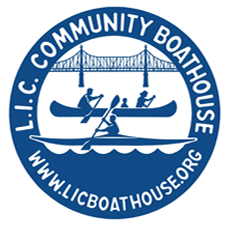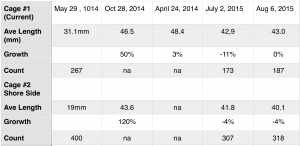LICCB’s Environmental Committee oversees several projects throughout the season, including maintaining an oyster garden, and actual garden on a ferry, and water quality testing.
Check out what we have been up to!
Oyster Gardening at Anable Basin
The Oyster Garden we maintain at Anable Basin is part of the Harbor-wide Billion Oyster Project (BOP), the regional initiative to restore oysters to the NY/NJ Harbor Estuary. To learn more about the BOP initiatives on the BOP website.
On August 6th we did another complete count of our two oyster garden cages. The data at first seemed underwhelming but upon reflection showed some curious anomalies.
The last two months is the peak of oysters’ growing season and is when the summer warmth triggers their spawning. Naturally, we expected to see a growth spurt over our measurement from early July. There were two surprises. First, our counts were higher than in early July. We would have expected somewhat fewer due to predators or natural mortality, but the count was actually greater. How much of this could be due to the untrained eyes of us citizen scientists? Do the counts reflect our enthusiasm to measure – or perhaps we just missed some last month or we were just seeing oysters we didn’t see before? The ‘cluster’ nature of our oyster population has always been a challenge to accurate counting and measurement. And as citizen scientists, we would expect some variation and even sloppiness.
The other surprise in August was that the average length in both cages did not change, in spite of being the height of the growing season. Here’s the data in a nutshell – Not the trends you would expect!!
We also continued to observe differences in the marine growth on the two cages and in the ‘reef associates’ in the cages.
More interesting was the difference in cage fouling and life within. The cage closest to shore had relatively few sea squirts, seaweed, sponges and other growths. Inside was our pet green crab, now measuring 3.5″. and several smaller ones, and lots of much smaller critters especially various types of shrimp And there were several unidentified fish over 4″ (see pic). A number of oysters were covered with a thickish rubbery looking/feeling growth. What is it? The clumps of blue mussels we observed in July were still clumped to the rope and cage by their stringy byssal threads.
The Outer Cage in the Current was so loaded with sea squirts that it took two of us to haul it up. There were few shrimp and green crabs, but some mud crabs, worms, and small fish (1.5″ that look like tadpoles – what are they?
The clumps of blue mussels we observed in July were still clumped to the rope and cage by their stringy byssal threads.
So the mystery remains. Why is the count up when we expected it to go down and why is the average length down when we expect it to rise?
One possibility is that the wild oysters’ larvae spawned (from somewhere) in 2014 settled on the oyster clumps in the oyster garden cages. Oysters, male and female, are broadcast spawners. When some of the eggs are fertilized, they develop into larvae and after some weeks metamorphose into tiny oysters and eventually settle (attach) on a substrate, preferably another larger oyster shell. These ‘spats’ then begin their lives as oysters. The spats remain very small, a mere speck on the larger oyster shells, but over the months become recognizable as small oysters. It seems likely that they had not grown enough to be recognized as oysters by our citizen scientists until our mid-summer monitoring in early August. We are waiting to hear what the marine biologists at the Billion Oyster Project think.
In Sept, we will get new seed oysters for a new cage we recently built, with its traps consisting of the ceramic tiles, oyster shells, and mesh. When we pulled this up, it was already thickly covered with heavy seaweed, some sea squirts, lots of spongelike growth (see pic) Lots of little tadpole-like fish jumping around and out of the seaweed.
Why do these two cages have so much fouling? Could they be too deep off the dock (6′)
And the basic questions remain – why didn’t our oysters grow (or did they?), and what is really going on??
Join us in Sept when we monitor our new oysters and continue monitoring last year’s cages. Date to be announced.
Reported by John Bradley
To be involved in or to be kept informed about this and related projects, contact oyster_monitoring_info@licboathouse.org
Wild Oysters in Anable Basin
At dead low tide on December 4, 2017, we walked along the mud flat by the south bulkhead in Anable Basin. Near the CSO on the steel bulkhead, we saw a cluster of wild oysters. They don’t look appetizing covered with muck, and they could be unhealthy as well as illegal, but it is great to see nature take its course as oysters slowly repopulate the East River.
Come and check out our oyster cages at a monitoring session this spring and summer. Watch the Boathouse calendar for event information.
Citizens Water Quality Testing (CWQT)
Several members of the LICCB are involved with the Citizen Water Quality Testing (CWQT) program run by the Water Trails Association. Throughout the NYC waterways, volunteers take water samples every Thursday morning, during boating season. The results are then published by Friday so river users can know if the waters are safe for kayaking, swimming, etc.
Currently, LICCB members help sample water from Hallett’s Cove, Anable Basin, and Newtown Creek.
If you are interested in participating in this project thru LICCB, contact water_sampling_info@licboathouse.org for scheduling and training. Also, read more about the CWQT program at the links below:
Garden on the Ferry
Last year, the environmental committee launched a new floating garden project on the ferry in Anable basin. There are now 2 raised beds on the ferry, but we want to expand!
We are looking for volunteers to help with garden design & construction, creating & coordinating watering schedules and assignments. This upcoming year we will be growing a variety of herbs and a few veggies. We look forward to having a fun area to gather and celebrate our Ferry Garden initiative.
Want to help? Contact ferry_garden_info@licboathouse.org
News from Around the River
Newtown Creek Vision Plan 2018
The NCA and Riverkeeper released their Vision in January. Newtown Creek is a favorite paddle for Superfund fascinated kayakers and canoeists. This report answers your many questions and is a fascinating read – History, ecology, economics, it’s all there.
Friends of Bushwick Inlet Park
Bushwick Inlet is another favorite paddling destination on the East River. With the City Budget inclusion of funds for the next stage of the Park, the Friends of BIP have undertaken their own Visioning process. Check it out.
A Wetland Park for Long Island City at 44 Drive
Community groups in Long Island City have petitioned for a Wetland Park on the city-owned shoreline parcel at 44 Drive. City Planning (DCP) and the Economic Development Commission (EDC) are planning to sell off the parcel to developers. Additionally, the community demands that the neighboring DOE building to be converted to schools to alleviate the severe shortage of school seats in this fast-growing community. Learn more about our East River Flood Plain facing Sea Rise here.
Cleaning the Shoreline
May 5, Cinco de Mayo is also the day of the Riverkeeper Sweep, opportunities to Clean the Shoreline from the Atlantic to the Adirondacks. One nearby opportunity is to join our friends at Bushwick Inlet Park.




